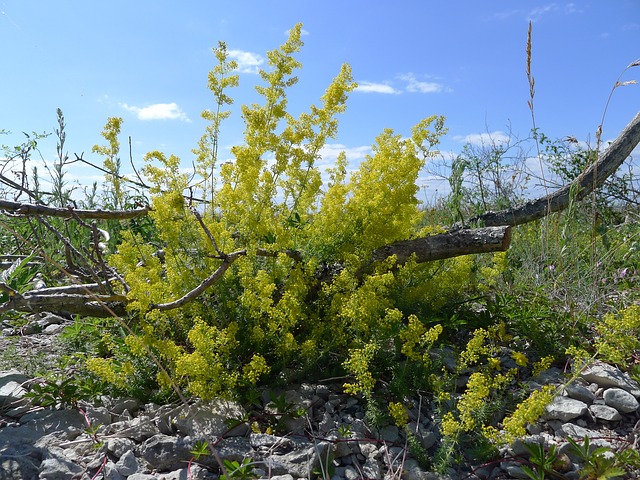 |  |   |  |  |
 |  |
The
lady’s Bedstraw
is one of the perennial plants. It has a branched root and a straight, weak, slightly raised stem that often touches the ground. All Bedstraws, including the true madara, are a plant that usually rests on other nearby plants and thus rises above the ground. If there are no other plants next to the
lady’s Bedstraw
, then the
lady’s Bedstraw
will only slightly rise above the ground. The stems of
lady’s Bedstraw
can reach up to 120 cm in length. The leaves are small, narrow, with pointed ends, shiny, dark green on top, velvety and grayish below, combined in clusters of 8-12 pieces. The flowers of the
lady’s Bedstraw
are small, bright yellow, symmetrical, collected in narrowed inflorescences.
All parts of the plant have medicinal properties, including the root, but usually only the surface part of the plant is harvested. It is cut during the flowering period, which begins in the second half of June and continues until September. The plant is dried in well-ventilated rooms or by placing it outside in a shady place where there are no strong drafts. Often the juice is squeezed from the plant and mixed with alcohol to extend its shelf life. The
lady’s Bedstraw
root is harvested throughout the summer season. The plant has an astringent and bitter taste.
The plant contains saponin steroids, iridoid glycosides, glycoside asperuloside, ascorbic acid and carotene, carotonoids, flavonoids, tannins and dyes, coumarins and anthraquinone. The plant is rich in various acids, including citric acid, ellagic acid, gallic acid, as well as phenolic carbonates. Lady’s Bedstraw
also contains trace elements - iron, copper, manganese, molybdenum, vanadium, zinc, nickel, chromium, thallium, titanium. However, the clotting enzyme renin is found only in leaves and flowers.
Medicinal significance
From a medical point of view, the medicinal properties of
lady’s Bedstraw
are little studied. However,
lady’s Bedstraw
is known to act as an anti-inflammatory and diuretic agent, as well as being able to normalize the blood glucose content.
By carrying out experiments with the
lady’s Bedstraw
extract, it was found that it has a diuretic effect, the decoction has an antipyretic and sedative effect. It has also been established that the decoction slows down brain activity. Therefore, the plant was recommended for further research as a preparation to treat epilepsy and febrile conditions.
The water extract of
lady’s Bedstraw
has antifibrinolytic and anticoagulant effects, and the dry extract has antispasmodic activity. The plant is also being studied as a promising antitumor agent. It has been proven that water stagnation inhibits the development of Pleis lymphosarcoma by 82% and also reduces leukocytosis in animals.
In folk medicine,
lady’s Bedstraw
is widely used. The fresh, crushed plant is used externally as a blood-stopping and wound-healing agent. Such applications are effective in the treatment of tears, rashes and skin diseases. Mixed with fat or oil, the
lady’s Bedstraw
herb turns into an ointment, which can also be used for various lacerations, ulcers, burns and scrofula. Dried and ground
lady’s Bedstraw
powder can be used in wound treatment.
The setting of the
lady’s Bedstraw
is used as a blood-stopping agent, it treats hemorrhoids, nosebleeds, as well as painful and heavy menstruation. It can also be used in case of dysentery, diarrhea, colitis and cutting pain in the stomach, gastritis, endometritis. It is also good as a diuretic, for the treatment of edema, kidney stones and nephritis. The
lady’s Bedstraw
is used as a pain reliever, especially effective for headaches and gout. As an anti-inflammatory and antipyretic, it is used in angina, lung inflammation, pneumonia, tuberculosis, brucellosis and scrofulosis.
In case of epilepsy and convulsions,
lady’s Bedstraw
works as an antipyretic. As a sedative, it is given to patients during attacks of hysteria and neurasthenia.
